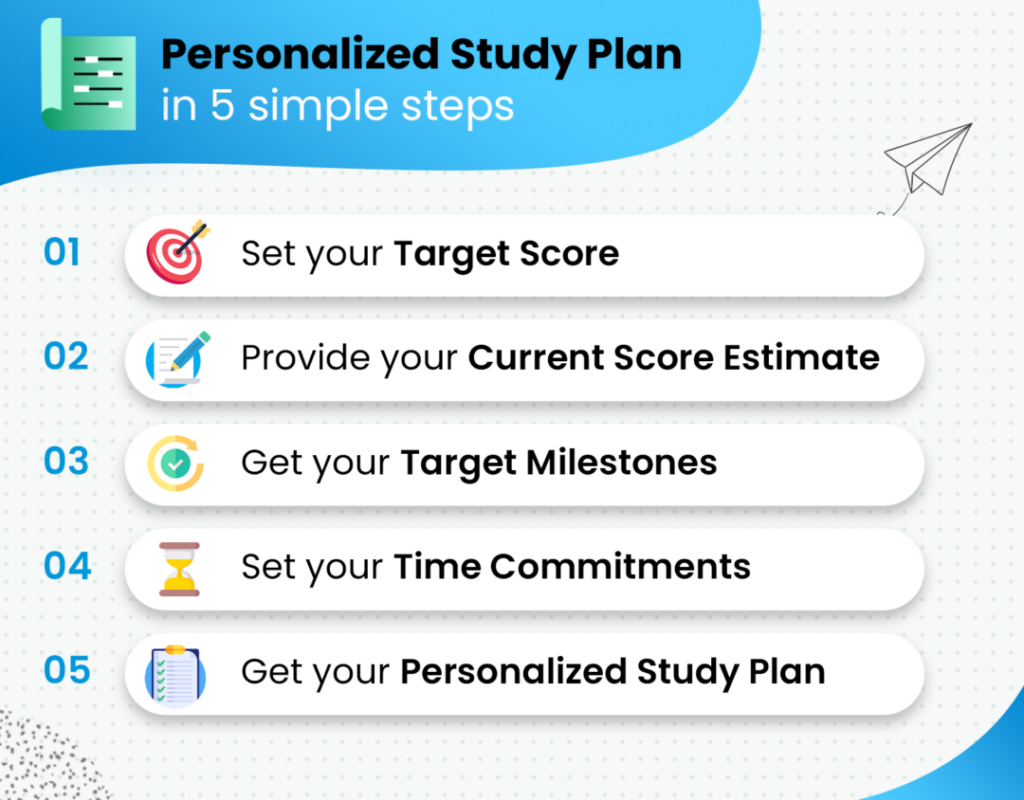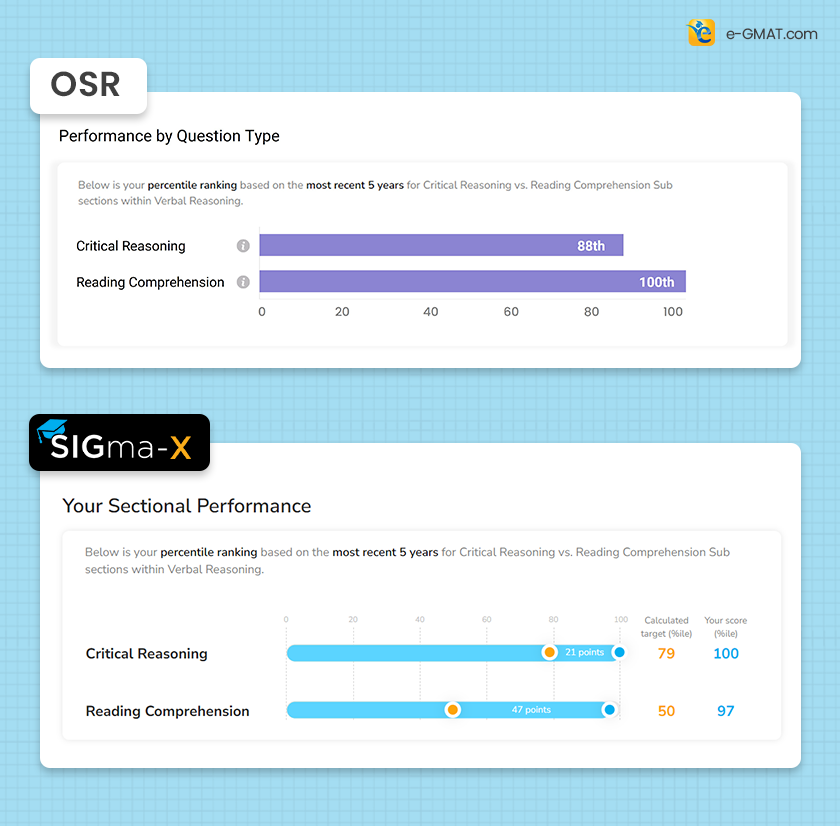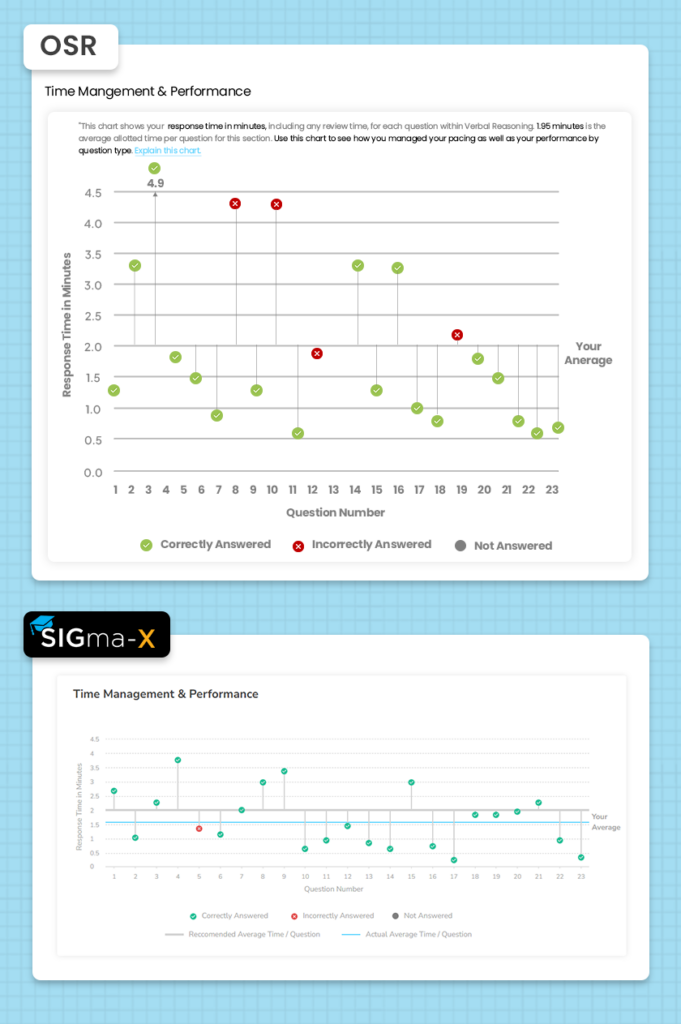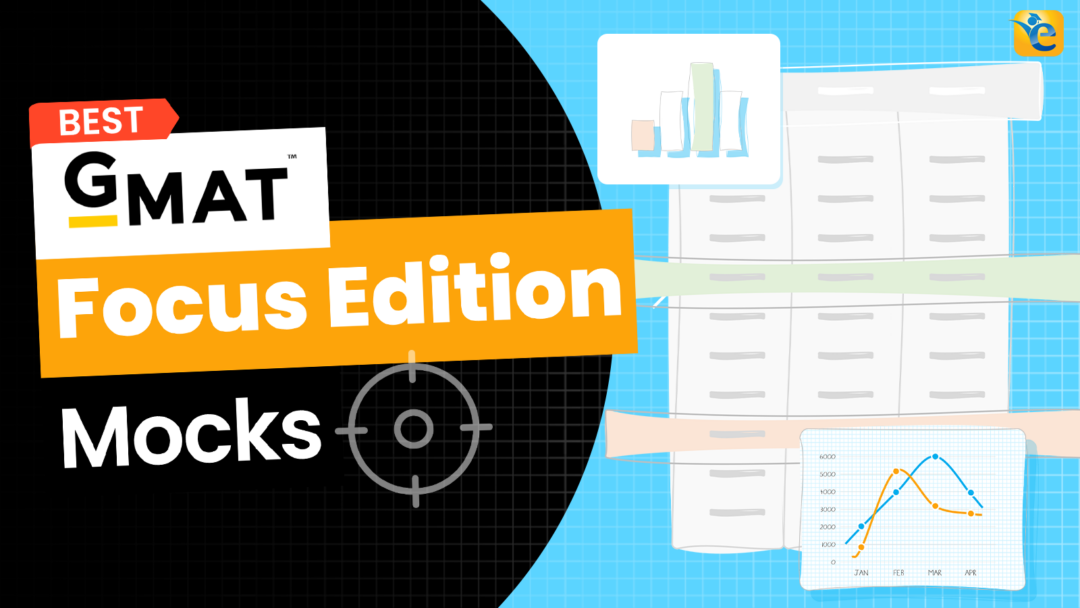If you are an MBA aspirant who has decided to give the GMAT exam but has no idea how to prepare for the GMAT Focus or where to begin your GMAT preparation, you have come to the right place. GMAT is one of the most important parts of your MBA application, and a strong GMAT score helps you stand out in your admission process and even secure scholarships. Also, your GMAT score is still completely in your control, unlike other parts of your application, such as your school/college grades. Thus, giving your best shot at it is that much more important.
In this article, we shall walk you through the four steps of GMAT preparation that have helped many students score 645+ on the GMAT Focus.
Start your GMAT preparation
Unsure about how to start your GMAT preparation? Get personalized recommendations
How to prepare for the GMAT? – 4 Steps!
- Step 1: Familiarize yourself with the format and content.
- Step 2: Create a Study plan and (more importantly) stick to it!
- Step 3: Choose the right GMAT prep materials suited to your needs.
- Step 4: Manage your test day nerves.

Before we proceed further, here is a quick outline of this article:
- Start your GMAT preparation
- Step 1: Familiarize yourself with the format and content
- Step 2: Create a study plan
- 1. Decide your target score
- 2. Take a mock test to understand baseline score
- 3. Decide whether your approach should be Quant driven, Verbal driven, or Data Insights driven
- 4. Estimate the amount of time you need
- 5. Create the sequence of study
- 6. Block time to take mocks
- Sample study plans on how to prepare for the GMAT
- Step 3: Using the right resources and executing the plan
- Step 4: Managing GMAT anxiety
- Conclusion
We invite you to read our GMAT Focus Edition Series Articles, an invaluable resource to keep you at the forefront of your GMAT preparation journey.
Here are the important dates for the GMAT Focus Edition.
- November 7, 2023 : GMAT Focus Edition testing began.
- February 1,2024: The Classic GMAT retired, GMAT Focus is the only version available.
Begin your GMAT preparation with the only prep company that has delivered more 700+ (GMAT Focus equivalent 645+) scores than any other GMAT club partner. Achieve GMAT 695+ with our AI driven tools that give you personalized feedback at every step of your GMAT journey. Take our free trial today!
Let us now understand the preparation steps one by one:
Step 1: Familiarize yourself with the format and content
The best way to understand the format is to test it by yourself. Take a Free Mock now.
GMAT Focus Edition (Launched – Nov 7,2023)
The GMAT Focus Edition 2024 is a 2-hour 15-minute long adaptive test that is used to assess your quantitative, verbal, and data insights skills. Each test taker is given a score between 205 to 805. This test consists of three sections. The details about the duration of each section, the number of questions, and the question types are as follows:
| GMAT Focus Edition Sections | No. of Questions | Question Types | Duration |
| Quantitative Reasoning | 21 multiple choice | Problem Solving, Algebra and Arithmetic | 45 minutes |
| Verbal Reasoning | 23 multiple choice | Reading Comprehension, Critical Reasoning | 45 minutes |
| Data Insights | 20 multiple choice | Data Sufficiency, Multi-source Reasoning, Table Analysis, Graphics Interpretation, Two-Part Analysis | 45 minutes |
Also, watch the following video to learn all about the GMAT Focus edition and also understand how to decide which version of the exam to take- The current version or the GMAT Focus edition.
Read our article on GMAT Focus Syllabus to know more about the latest exam pattern, GMAT sections and question types
We also recommend that you familiarize yourself with each sub-section in GMAT Quant, Verbal and Data Insights, and solve 1-2 official questions from each section to get a feel of what questions are asked. Here are the detailed insights into each subsection of Verbal and Quant and a few official questions from each question type/ subsection with detailed solutions. Try your hand at the same:
What is GMAT Reading Comprehension + Sample questions on GMAT RC
What is GMAT Critical reasoning + Sample questions on GMAT CR
Step 2: Create a study plan
Creating a study plan is probably the most critical part of GMAT preparation. If done right, a personalized study plan can save you 60+ hours in your preparation. Therefore, your first step in your GMAT preparation must be creating a personalized study plan that suits your needs. Here are the steps to create a personalized study plan:
- Decide your target score
- Take a mock test to understand your baseline scores
- Decide whether your approach should be Verbal driven, Quant driven, or DI driven
- Estimate the amount of time you need
- Create the sequence of study
- Block the time to take mocks
We recommend you to read – GMAT Focus Study Plan also.

Let us understand each of these steps in detail:
1. Decide your target score
Deciding your target GMAT score largely depends on the college you are targeting. We recommend that you score at least 20 points above the class average to increase your chances of admission and to secure a scholarship. For example, if the college you are targeting has an average GMAT score of 675, you should target to score 695+.
The average GMAT score for the top 30 colleges in US is 655. Therefore, if you are targeting these schools, you must target to score 675+.
Read our article on what is a good GMAT score to understand what is the ideal score for your target B-school and the five steps to find your target GMAT score
2. Take a mock test to understand baseline score
Once you have decided your target GMAT score, the next step is understanding where you currently stand and how much gap you need to bridge. To do this, you must have a baseline score. But merely having a baseline score will not help. You must have a detailed insight about your sectional scores and what subsections are your strengths and weaknesses within each section. You must also understand how you progressed within each section. These data points will help you determine whether you need to work on your basic concepts or only your application skills. They will also help you determine your time management strategies. Getting insights at such a molecular level may seem tedious and time-consuming, but as Abraham Lincoln once said, “If you only had an hour to chop down a tree, spend the first 45 minutes sharpening your axe.”
Planning with such attention to detail will only save you time in the future and ensure that you only target those areas that need to be improved.
The next question you would have is: How do I get these baseline scores?
For this, we recommend two strategies, depending on whether you are taking the GMAT for the first time or are a retaker:
- If you have already given the GMAT recently, you can get an Official Score Report at no additional cost. This report will give you:
- Performance summary charts provide a view into your performance across the entire exam:
- Performance by Section – provides an overview of your Total Score, section scores, and your percentile ranking for each. Use this chart to get an overview of your score.
- Performance by Program & School – shows your Total Score percentile ranking compared to the percentile rankings of test takers who sent their GMAT scores to the same program within the past 5 years. Use this chart to see how you stack up against others who are interested in applying to the same program(s).
- Subsection charts provide details about how you performed on specific domains within the Verbal Reasoning, Quantitative Reasoning, and Data Insights sections.
- Performance by Content Domain – shows your percentile ranking based on the most recent 5 years of data for each content domain within the individual section. Use this chart to see how you performed on different content domains within the section, and where you have strengths and opportunities for improvement.
- Performance by Question Type – shows your percentile ranking based on the most recent 5 years of data for each question type within the individual section. Use this chart to see how you performed on different question types within the section, and where you have strengths and opportunities for improvement.
- Performance by Fundamental Skills – shows your percentile ranking based on the most recent 5 years of data for each fundamental skill within the individual section. Use this chart to see how you performed on different fundamental skills within the section, and where you have strengths and opportunities for improvement.
- Time Management & Performance – shows your response time in minutes, including any review time, for each question within the individual section. Use this chart to see how you managed your pacing compared to the average expected time spent per question in the section, as well as your performance by question.
- Summary of Question Review & Changes – shows your review activity for that section, including how much time you spent reviewing and editing questions in the section. Use this chart to help you evaluate whether or not changing your answers improved your performance.
2) If you are first time test taker, haven’t taken the GMAT recently or even otherwise, you can give the e-GMAT Sigma-X mock test, that is completely free of cost. The insights provided by Sigma-X mocks go above and beyond those provided by the ESR. You will not only be given insights into all of the above mentioned points, but also understand how much time you spent on each question, was there any luck factor, timing influence, or rush through factor in your performance.


Are you planning to pursue MBA at top business schools? Let us help you conquer the first step of the process i.e., taking the GMAT. Take a free mock test to understand your baseline score and start your GMAT prep with our free trial. We are the most reviewed online GMAT Prep company with 2900+ reviews on GMATClub.
3. Decide whether your approach should be Quant driven, Verbal driven, or Data Insights driven
Did you know that there are so many different ways to get a score of 645? You could get a score of Q77, V86 and DI83 to get a GMAT 645. Alternatively, you can also score Q85, V80 and DI81. While Q85 is equivalent to 88th percentile in the GMAT, a Q77 is a mere 43rd percentile. Therefore, choose your path wisely depending on whether your strong area is Verbal, Quant or Data Insights.
The insights derived from the previous step will come in handy to determine whether your approach should be Quant driven, Verbal driven, or DI driven. You must also decide what sub-sections within Quant, Verbal, and Data Insights are your strengths and weaknesses to develop an efficient plan.
4. Estimate the amount of time you need
Now that you have your target GMAT score, a detailed insight into your baseline scores, and your approach sorted, you are ready to estimate the amount of time you need for your GMAT preparation.

If your approach to GMAT preparation is dedicated, consistent, and data-driven, you would need approximately 7 hours of study to improve by 10 points (on a scale of 805) in the total score. This is usually the case with Online courses as they are more engaging and provide active feedback. This not only makes it easier for students to concentrate longer and better but also ensures that students require half as many revisions to reach a high level of competence. However, if you are using books to study, you would need approximately 12 hours per 10 points (scale of 805) of improvement.
Also, you will need more time if you are extremely weak in a particular topic. For example, if a student’s starting percentile in Critical Reasoning is 25th percentile, then the student should add 25% to this time estimate (for Critical Reasoning only). The same holds true if you are truly weak in GMAT Quant. Let’s call this factor Confidence Building Time (CBT).
So, with the above estimates, a diligent student seeking 100-point improvement should be able to do so by using a data-driven online course in as few as 80 hours. Similarly, a 200-point score improvement would require 160 hours of effort using the same online course.
To conclude it all, here is a simple thumb rule to estimate the amount of time required:
Time required (in hours) = [Target GMAT Score – Starting GMAT Score] X [ 7/10] X [1+CBT]
Where:
- Target GMAT Score = final score that you desire
- Starting GMAT score = Starting score on an official mock test
- 7/10 = 7 hours of effort for every 10 point score improvement
- CBT = Confidence Building Time factor; its value can be 0.0 or 0.25
5. Create the sequence of study
Once you estimate the time needed to prepare, you must block the time off in your calendar so that you do not plan other activities and keep with your schedule. We recommend that you start with your relative strength so that it can set a good momentum for the rest of your preparation.
For Verbal, you must start with CR. Only when you have reached your target score in CR, you must move to RC. The reason for this order is that RC requires certain skills that get developed in CR. Preparing for CR would automatically improve your skills in RC to a certain level.
For Quant, you can start with Number Properties and follow it up with Word Problems, Algebra, and Advanced Topics in this order.
For Data Insights, you can start with Graphics Interpretation and Table Analysis (GITA) and follow it up with Two-Part Analysis (TPA), Data Sufficiency (DS) and Multi-Source Reasoning (MSR) in this order.
No matter which section you begin with, ensure that you only study one topic at a time. Do not jump to another topic midway. For example, if you are studying SC, ensure that you finish it before moving to, say, Number Properties. This focused approach will ensure that you gain mastery in one section before moving on to another.
6. Block time to take mocks

Ensure you include enough time for Cementing quizzes which are sub-sectional tests in your study plan. We recommend that you take at least 3 medium and hard-level tests of 10 questions each in every sub-section before studying the next sub-section. This will ensure that you gain mastery in the subsection and help you retain everything you have learned for a longer period. The Cementing stage will take around 10 hours for every subsection. It would include time to give the tests and review each question of each test. You will see this time allocated as Stage 2 – Cementing in your PSP. If you have not created the PSP, set aside around 10 hours for every subsection for cementing your abilities.
Students generally believe that you need to take a lot of mocks to ace the GMAT exam, however this is a myth. Taking a large number of mocks is of no use. The analysis done at the end of each mock is what matters. At e-GMAT, we recommend taking 3-4 full length mocks only after you have finished studying everything. Ensure that you analyse each mock in detail, as explained in step 2 above. You will not need to give a lot of mocks as you have already given umpteen number of sub-sectional tests. The mocks should only be taken to become test ready. All the learning should be completed by the time you reach this stage. So, we recommend setting aside another 30-40 hours for this activity.
If you are an e-GMAT student, you can skip steps 3, 4, 5, and 6 and directly go to the PSP tool after giving your Sigma-X mock. The PSP tool will give you a detailed day-wise plan once you enter your target overall and sub-sectional scores. You can adjust the sub-sectional scores based on your strengths, and the tool will automatically adjust the other sub-sectional scores for the given target score. You can also put in the number of hours you are willing to put in every day, and the tool will give you the plan accordingly.

Read this article to understand how to use the personalized study planner tool.
In case you aren’t an e-GMAT student, please write to us at support@e-gmat so that we can help you with the personalized study plan.
Sample study plans on how to prepare for the GMAT
Here are some tips on how to create the study plans and some sample study plans that suit your needs:
1) How to create your GMAT Study plan- Sample GMAT study plan and schedule
2) How to create a study plan for working professionals
3) Sample plan and tips for creating study plan for 1 month study
Now that you have your study plan ready, it is time to execute your plan and start studying. This is where step 3 comes in.
Step 3: Using the right resources and executing the plan
Before we get into how to select the right resources for your study, let us first understand the different steps of studying for the GMAT exam. At e-GMAT, we believe in a 3-stage learning process that has proven useful for thousands of students who got a 700+ (GFE Equivalent 645+) score:
Stage 1: Learning Concepts and Methodologies
This is the phase wherein we learn all the concepts in a sub-section and learn the process of solving the questions in that sub-section.
Stage 2: Cementing
In this phase, we cement our learnings by first solving medium-difficulty questions and then hard questions. We start with relaxed timing and then progress to standard timing. Standard timing is the speed at which you’ll be expected to take the actual GMAT.
Stage 3: Test Readiness
This is the final phase of your prep. This is where you write full-length mocks to determine whether you’re ready for the GMAT or need to work on cementing your individual skills further.

Picking the right study material depends on which of the above three stages you are at. You can easily do so using the data obtained from step 1 and step 2 of Creating a study plan, that is, your target GMAT score and your starting abilities. For example, if your starting ability is below 595, you may have to start from Stage 1. However, you have a starting score of 645+ and are looking to improve by 20-30 points, you may only need to work on your Cementing and test readiness. You may not need to learn all the concepts.
Also, if you are looking to save time in your preparation, going for an online course which gives you regular feedback will be better. The e-GMAT online course gives you a personalized study plan, personalized customer support, data analytics and tracks your progress for predictable success, all of which aren’t possible if you choose to prepare using books. Take our free trial to see this for yourself!
To make an informed decision about your GMAT prep material, read our article on the Best GMAT preparation books and online resources where we compare some of the best GMAT preparation resources and their usefulness in the 3 stages of learning.
Step 4: Managing GMAT anxiety
It is natural to feel anxious about giving the GMAT exam, given that the stakes are so high and that your GMAT score plays a huge role in deciding your career trajectory and your earning potential in the years to come. While you prepare for all the other aspects of the exam, ensure that you prepare yourself mentally to handle the stress and the test day nerves too, so that you do not get overwhelmed.

Read our article on the 10 tips to tackle GMAT anxiety to understand how to overcome this anxiety
Conclusion
In conclusion, understanding the format and structure of the exam is the first step in your GMAT preparation journey. Creating a study plan by understanding your target and baseline scores is the next and probably the most important step. Once you have the study plan, utilize the right resources that suit your needs to make the best utilization of your prep time. Finally, ensure that you have your GMAT anxiety under control. But above all, ensure that you work hard and are sincere in your preparation, as there is no shortcut to GMAT success! We hope this article has given you an in depth insight on how you should prepare for the GMAT. So what are you waiting for? Get started with your GMAT preparation today!
If you are planning to take the GMAT, we can help you with a personalized study plan and give you access to quality online content to prepare. Write to us at acethegmat@e-gmat.com. We are the most reviewed GMAT prep company on gmatclub with 2600+ reviews. Why don’t you take a free trial and judge for yourself?












